Accounting Principles, Financial Statements, and Cash Flow Analysis
VerifiedAdded on 2022/11/25
|26
|4285
|155
Homework Assignment
AI Summary
This accounting assignment solution provides a detailed analysis of financial accounting principles and their practical applications. It begins with an introduction to financial accounting and its significance, followed by a breakdown of Scenario 1, which covers business transactions, the double-entry system, and the trial balance. The solution includes journal entries, ledger accounts, and a trial balance for a given period. Scenario 2 focuses on financial reports versus financial statements and the fundamental accounting principles, including full disclosure, accrual, matching, and revenue recognition principles. The assignment also includes the preparation of an income statement and a statement of financial position, along with a cash flow statement. The solution demonstrates a strong understanding of accounting concepts, financial statement analysis, and the importance of accurate financial reporting for decision-making. The solution incorporates the profit and loss account and balance sheet with detailed calculations and explanations. This document provides a complete and well-structured response to the assignment requirements, making it a valuable resource for students studying financial accounting.
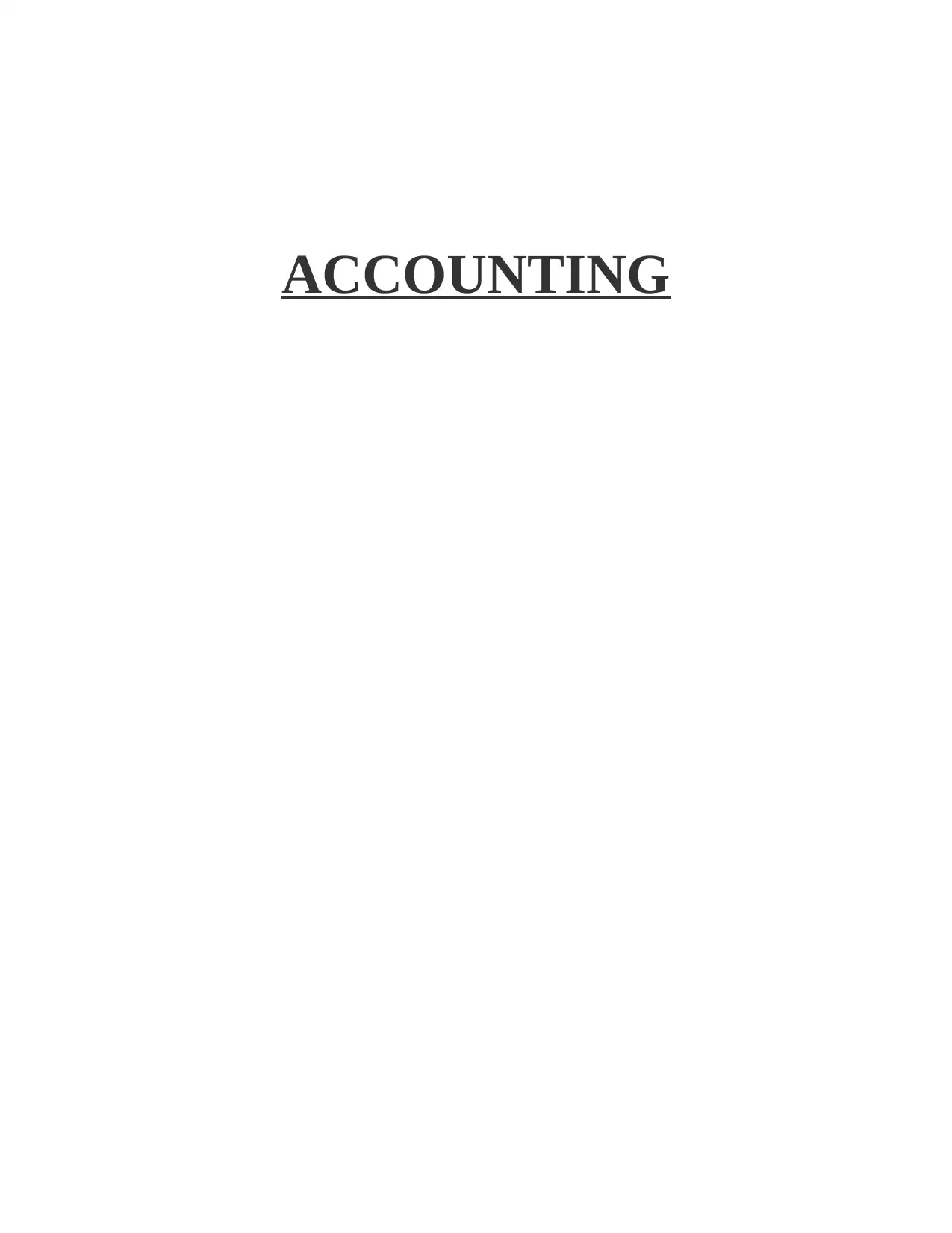
ACCOUNTING
Paraphrase This Document
Need a fresh take? Get an instant paraphrase of this document with our AI Paraphraser
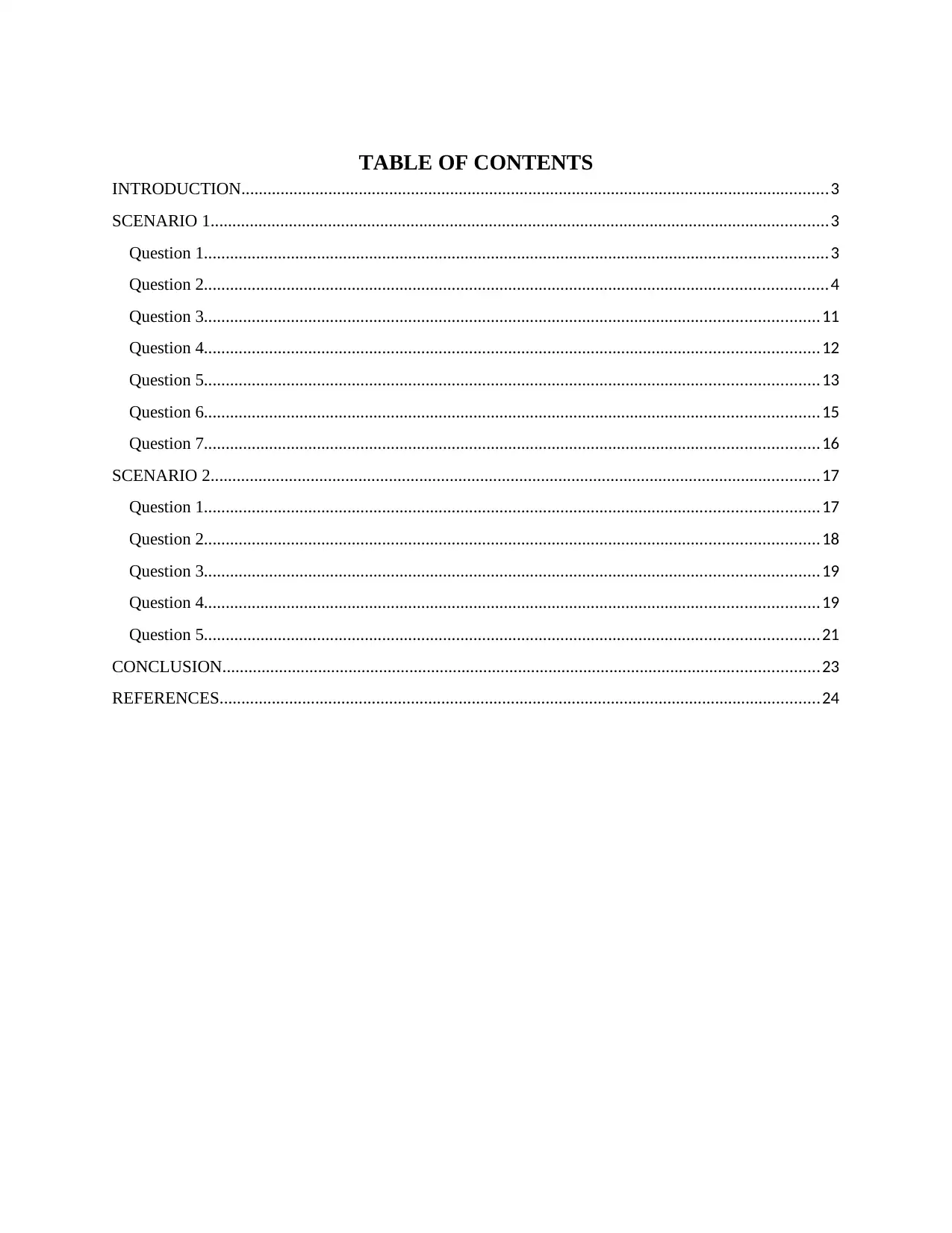
TABLE OF CONTENTS
INTRODUCTION.......................................................................................................................................3
SCENARIO 1..............................................................................................................................................3
Question 1...............................................................................................................................................3
Question 2...............................................................................................................................................4
Question 3.............................................................................................................................................11
Question 4.............................................................................................................................................12
Question 5.............................................................................................................................................13
Question 6.............................................................................................................................................15
Question 7.............................................................................................................................................16
SCENARIO 2............................................................................................................................................17
Question 1.............................................................................................................................................17
Question 2.............................................................................................................................................18
Question 3.............................................................................................................................................19
Question 4.............................................................................................................................................19
Question 5.............................................................................................................................................21
CONCLUSION.........................................................................................................................................23
REFERENCES..........................................................................................................................................24
INTRODUCTION.......................................................................................................................................3
SCENARIO 1..............................................................................................................................................3
Question 1...............................................................................................................................................3
Question 2...............................................................................................................................................4
Question 3.............................................................................................................................................11
Question 4.............................................................................................................................................12
Question 5.............................................................................................................................................13
Question 6.............................................................................................................................................15
Question 7.............................................................................................................................................16
SCENARIO 2............................................................................................................................................17
Question 1.............................................................................................................................................17
Question 2.............................................................................................................................................18
Question 3.............................................................................................................................................19
Question 4.............................................................................................................................................19
Question 5.............................................................................................................................................21
CONCLUSION.........................................................................................................................................23
REFERENCES..........................................................................................................................................24
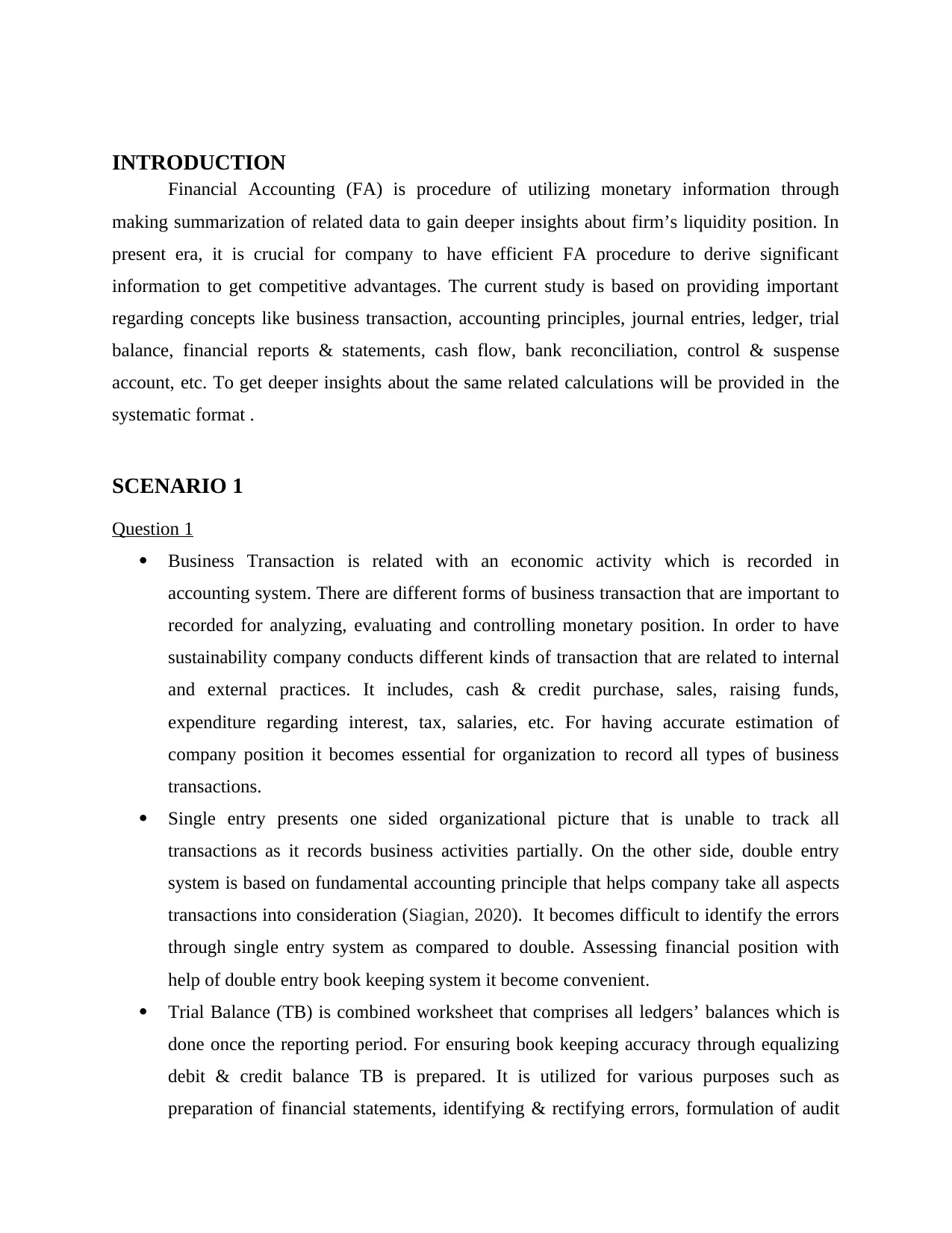
INTRODUCTION
Financial Accounting (FA) is procedure of utilizing monetary information through
making summarization of related data to gain deeper insights about firm’s liquidity position. In
present era, it is crucial for company to have efficient FA procedure to derive significant
information to get competitive advantages. The current study is based on providing important
regarding concepts like business transaction, accounting principles, journal entries, ledger, trial
balance, financial reports & statements, cash flow, bank reconciliation, control & suspense
account, etc. To get deeper insights about the same related calculations will be provided in the
systematic format .
SCENARIO 1
Question 1
Business Transaction is related with an economic activity which is recorded in
accounting system. There are different forms of business transaction that are important to
recorded for analyzing, evaluating and controlling monetary position. In order to have
sustainability company conducts different kinds of transaction that are related to internal
and external practices. It includes, cash & credit purchase, sales, raising funds,
expenditure regarding interest, tax, salaries, etc. For having accurate estimation of
company position it becomes essential for organization to record all types of business
transactions.
Single entry presents one sided organizational picture that is unable to track all
transactions as it records business activities partially. On the other side, double entry
system is based on fundamental accounting principle that helps company take all aspects
transactions into consideration (Siagian, 2020). It becomes difficult to identify the errors
through single entry system as compared to double. Assessing financial position with
help of double entry book keeping system it become convenient.
Trial Balance (TB) is combined worksheet that comprises all ledgers’ balances which is
done once the reporting period. For ensuring book keeping accuracy through equalizing
debit & credit balance TB is prepared. It is utilized for various purposes such as
preparation of financial statements, identifying & rectifying errors, formulation of audit
Financial Accounting (FA) is procedure of utilizing monetary information through
making summarization of related data to gain deeper insights about firm’s liquidity position. In
present era, it is crucial for company to have efficient FA procedure to derive significant
information to get competitive advantages. The current study is based on providing important
regarding concepts like business transaction, accounting principles, journal entries, ledger, trial
balance, financial reports & statements, cash flow, bank reconciliation, control & suspense
account, etc. To get deeper insights about the same related calculations will be provided in the
systematic format .
SCENARIO 1
Question 1
Business Transaction is related with an economic activity which is recorded in
accounting system. There are different forms of business transaction that are important to
recorded for analyzing, evaluating and controlling monetary position. In order to have
sustainability company conducts different kinds of transaction that are related to internal
and external practices. It includes, cash & credit purchase, sales, raising funds,
expenditure regarding interest, tax, salaries, etc. For having accurate estimation of
company position it becomes essential for organization to record all types of business
transactions.
Single entry presents one sided organizational picture that is unable to track all
transactions as it records business activities partially. On the other side, double entry
system is based on fundamental accounting principle that helps company take all aspects
transactions into consideration (Siagian, 2020). It becomes difficult to identify the errors
through single entry system as compared to double. Assessing financial position with
help of double entry book keeping system it become convenient.
Trial Balance (TB) is combined worksheet that comprises all ledgers’ balances which is
done once the reporting period. For ensuring book keeping accuracy through equalizing
debit & credit balance TB is prepared. It is utilized for various purposes such as
preparation of financial statements, identifying & rectifying errors, formulation of audit
⊘ This is a preview!⊘
Do you want full access?
Subscribe today to unlock all pages.

Trusted by 1+ million students worldwide
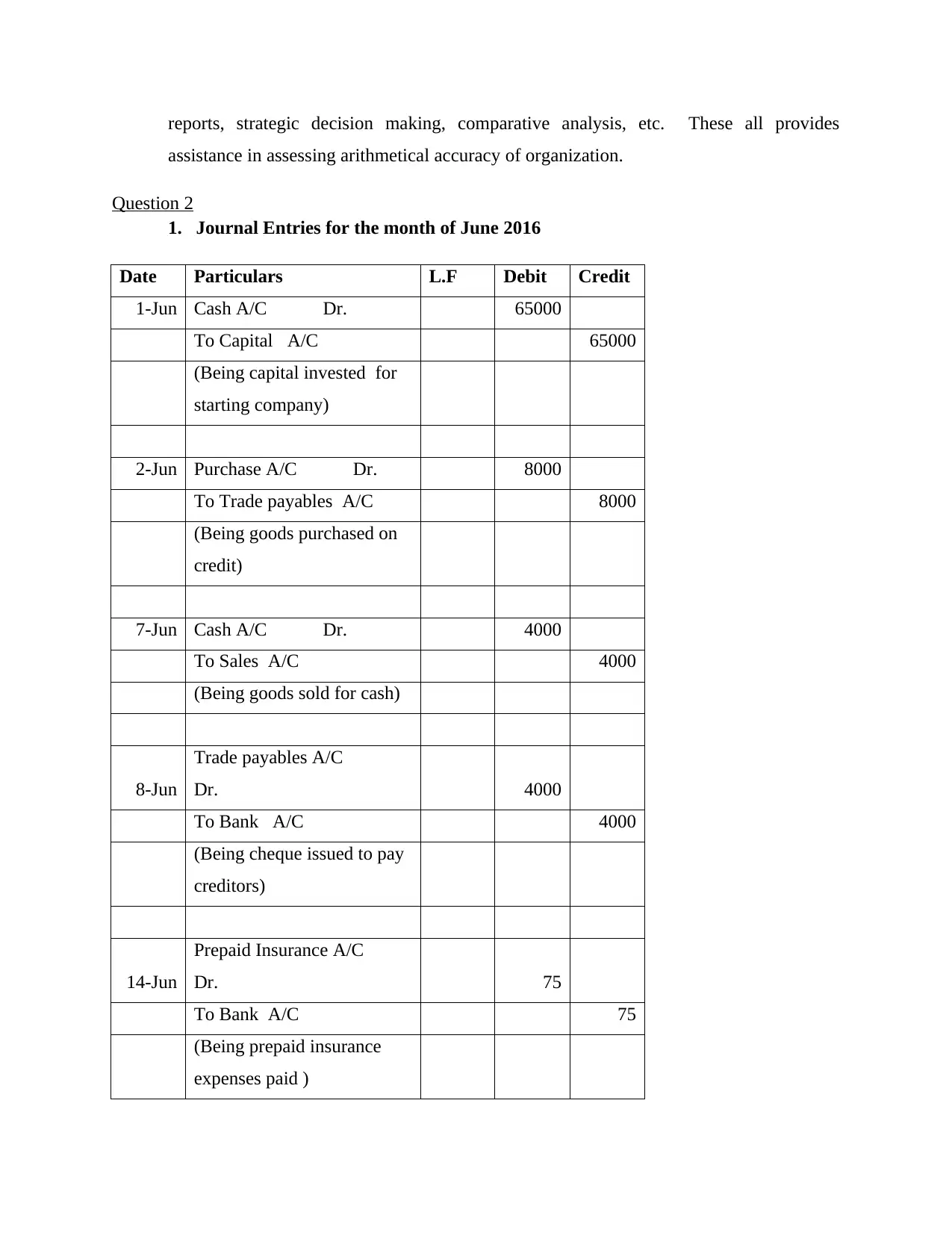
reports, strategic decision making, comparative analysis, etc. These all provides
assistance in assessing arithmetical accuracy of organization.
Question 2
1. Journal Entries for the month of June 2016
Date Particulars L.F Debit Credit
1-Jun Cash A/C Dr. 65000
To Capital A/C 65000
(Being capital invested for
starting company)
2-Jun Purchase A/C Dr. 8000
To Trade payables A/C 8000
(Being goods purchased on
credit)
7-Jun Cash A/C Dr. 4000
To Sales A/C 4000
(Being goods sold for cash)
8-Jun
Trade payables A/C
Dr. 4000
To Bank A/C 4000
(Being cheque issued to pay
creditors)
14-Jun
Prepaid Insurance A/C
Dr. 75
To Bank A/C 75
(Being prepaid insurance
expenses paid )
assistance in assessing arithmetical accuracy of organization.
Question 2
1. Journal Entries for the month of June 2016
Date Particulars L.F Debit Credit
1-Jun Cash A/C Dr. 65000
To Capital A/C 65000
(Being capital invested for
starting company)
2-Jun Purchase A/C Dr. 8000
To Trade payables A/C 8000
(Being goods purchased on
credit)
7-Jun Cash A/C Dr. 4000
To Sales A/C 4000
(Being goods sold for cash)
8-Jun
Trade payables A/C
Dr. 4000
To Bank A/C 4000
(Being cheque issued to pay
creditors)
14-Jun
Prepaid Insurance A/C
Dr. 75
To Bank A/C 75
(Being prepaid insurance
expenses paid )
Paraphrase This Document
Need a fresh take? Get an instant paraphrase of this document with our AI Paraphraser
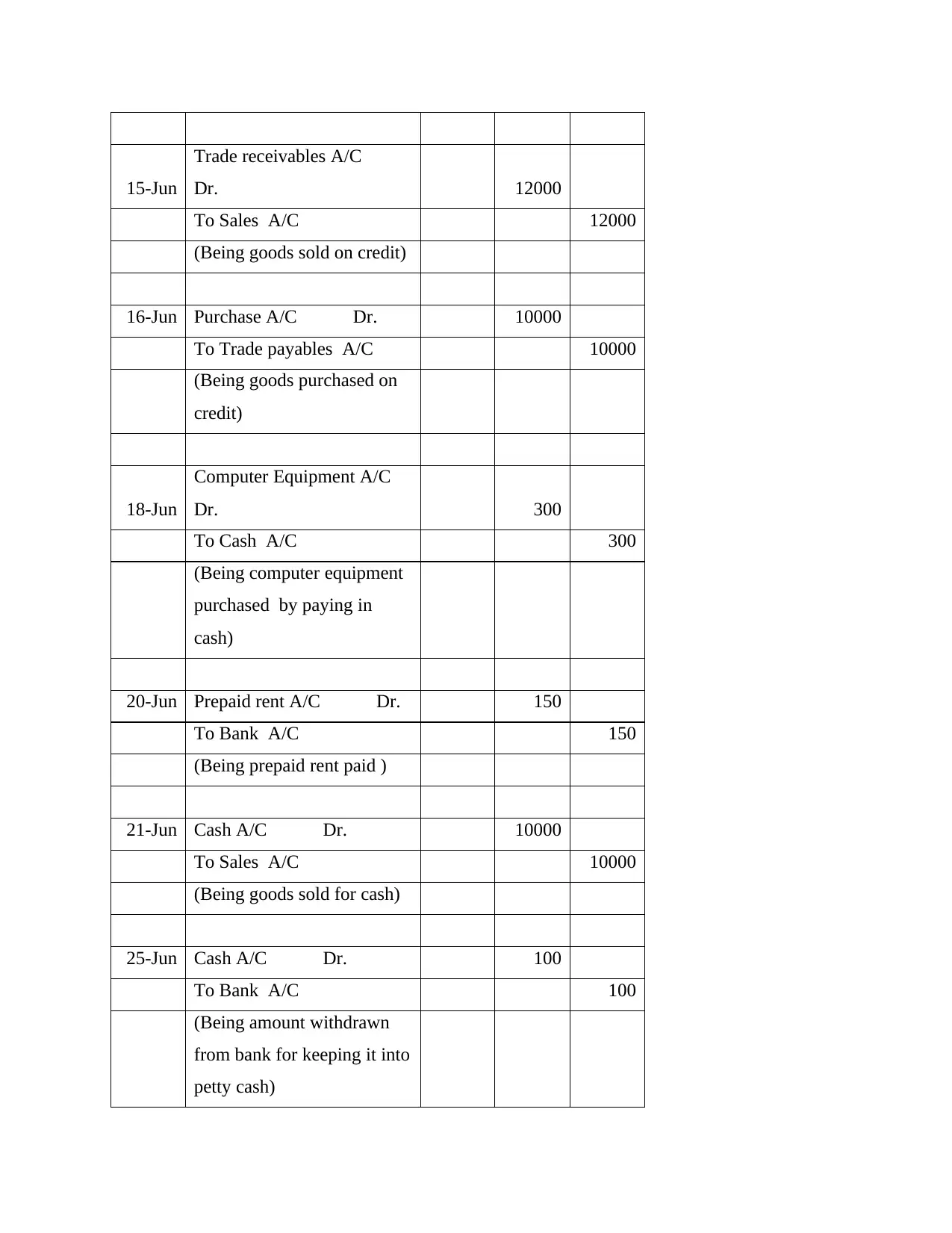
15-Jun
Trade receivables A/C
Dr. 12000
To Sales A/C 12000
(Being goods sold on credit)
16-Jun Purchase A/C Dr. 10000
To Trade payables A/C 10000
(Being goods purchased on
credit)
18-Jun
Computer Equipment A/C
Dr. 300
To Cash A/C 300
(Being computer equipment
purchased by paying in
cash)
20-Jun Prepaid rent A/C Dr. 150
To Bank A/C 150
(Being prepaid rent paid )
21-Jun Cash A/C Dr. 10000
To Sales A/C 10000
(Being goods sold for cash)
25-Jun Cash A/C Dr. 100
To Bank A/C 100
(Being amount withdrawn
from bank for keeping it into
petty cash)
Trade receivables A/C
Dr. 12000
To Sales A/C 12000
(Being goods sold on credit)
16-Jun Purchase A/C Dr. 10000
To Trade payables A/C 10000
(Being goods purchased on
credit)
18-Jun
Computer Equipment A/C
Dr. 300
To Cash A/C 300
(Being computer equipment
purchased by paying in
cash)
20-Jun Prepaid rent A/C Dr. 150
To Bank A/C 150
(Being prepaid rent paid )
21-Jun Cash A/C Dr. 10000
To Sales A/C 10000
(Being goods sold for cash)
25-Jun Cash A/C Dr. 100
To Bank A/C 100
(Being amount withdrawn
from bank for keeping it into
petty cash)
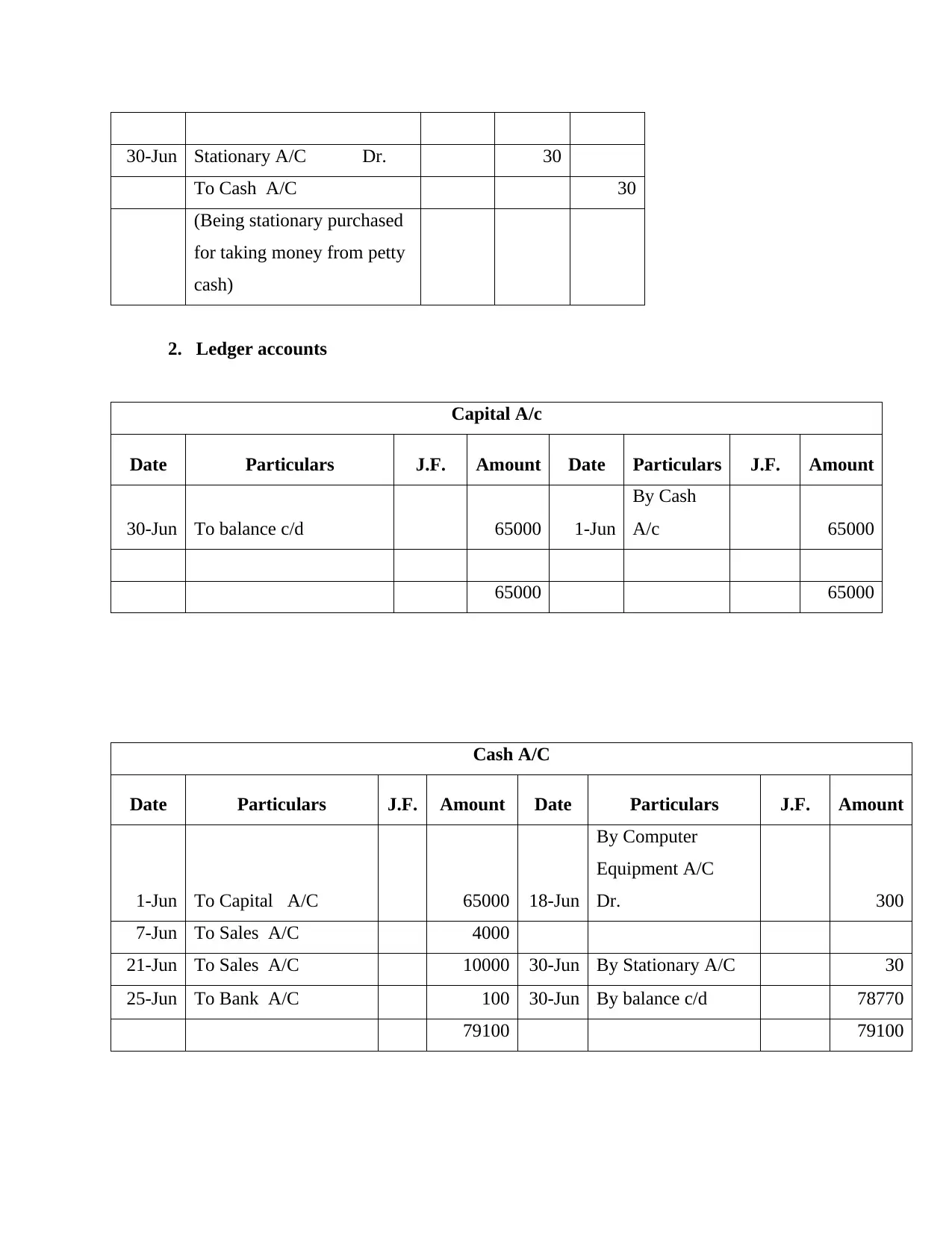
30-Jun Stationary A/C Dr. 30
To Cash A/C 30
(Being stationary purchased
for taking money from petty
cash)
2. Ledger accounts
Capital A/c
Date Particulars J.F. Amount Date Particulars J.F. Amount
30-Jun To balance c/d 65000 1-Jun
By Cash
A/c 65000
65000 65000
Cash A/C
Date Particulars J.F. Amount Date Particulars J.F. Amount
1-Jun To Capital A/C 65000 18-Jun
By Computer
Equipment A/C
Dr. 300
7-Jun To Sales A/C 4000
21-Jun To Sales A/C 10000 30-Jun By Stationary A/C 30
25-Jun To Bank A/C 100 30-Jun By balance c/d 78770
79100 79100
To Cash A/C 30
(Being stationary purchased
for taking money from petty
cash)
2. Ledger accounts
Capital A/c
Date Particulars J.F. Amount Date Particulars J.F. Amount
30-Jun To balance c/d 65000 1-Jun
By Cash
A/c 65000
65000 65000
Cash A/C
Date Particulars J.F. Amount Date Particulars J.F. Amount
1-Jun To Capital A/C 65000 18-Jun
By Computer
Equipment A/C
Dr. 300
7-Jun To Sales A/C 4000
21-Jun To Sales A/C 10000 30-Jun By Stationary A/C 30
25-Jun To Bank A/C 100 30-Jun By balance c/d 78770
79100 79100
⊘ This is a preview!⊘
Do you want full access?
Subscribe today to unlock all pages.

Trusted by 1+ million students worldwide
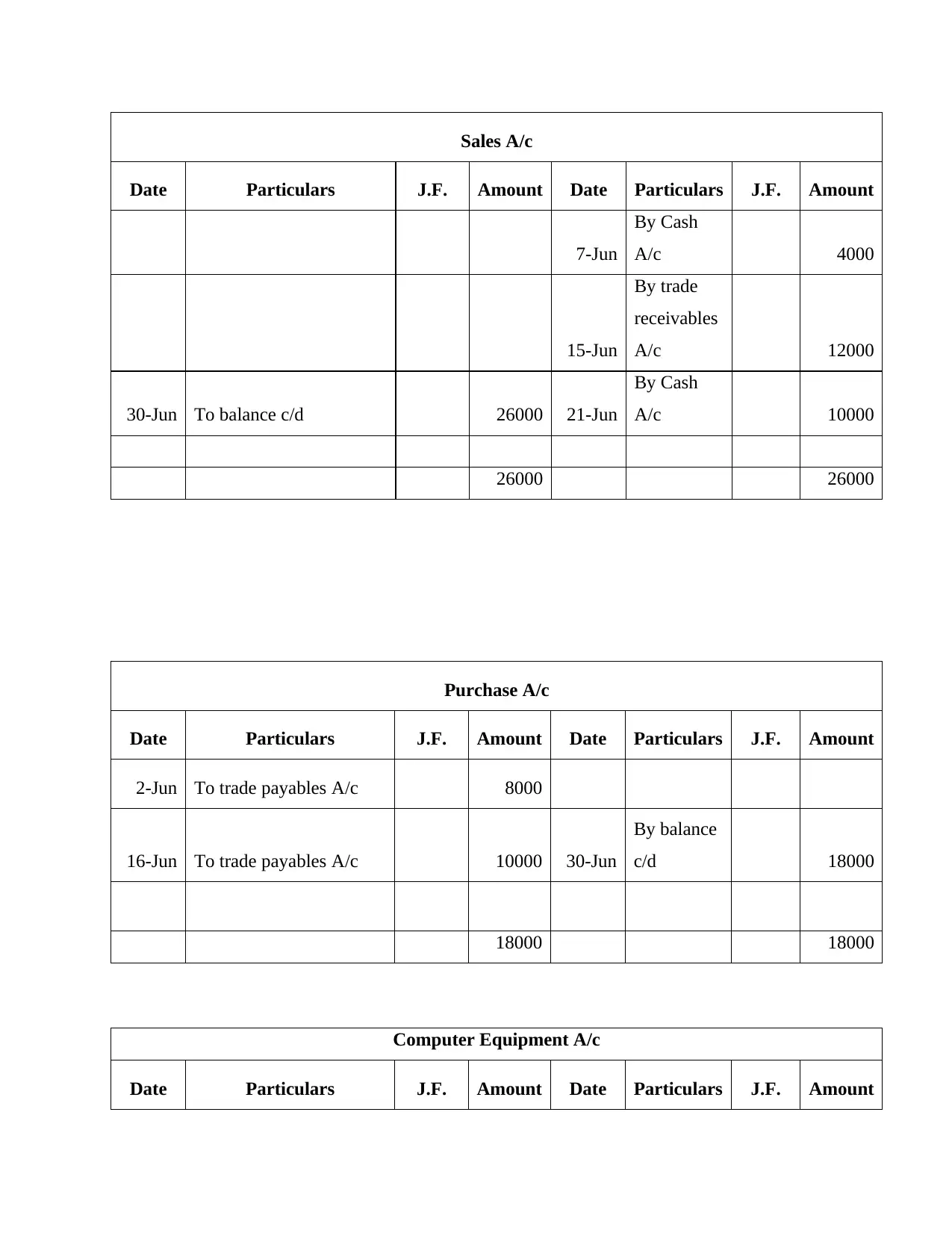
Sales A/c
Date Particulars J.F. Amount Date Particulars J.F. Amount
7-Jun
By Cash
A/c 4000
15-Jun
By trade
receivables
A/c 12000
30-Jun To balance c/d 26000 21-Jun
By Cash
A/c 10000
26000 26000
Purchase A/c
Date Particulars J.F. Amount Date Particulars J.F. Amount
2-Jun To trade payables A/c 8000
16-Jun To trade payables A/c 10000 30-Jun
By balance
c/d 18000
18000 18000
Computer Equipment A/c
Date Particulars J.F. Amount Date Particulars J.F. Amount
Date Particulars J.F. Amount Date Particulars J.F. Amount
7-Jun
By Cash
A/c 4000
15-Jun
By trade
receivables
A/c 12000
30-Jun To balance c/d 26000 21-Jun
By Cash
A/c 10000
26000 26000
Purchase A/c
Date Particulars J.F. Amount Date Particulars J.F. Amount
2-Jun To trade payables A/c 8000
16-Jun To trade payables A/c 10000 30-Jun
By balance
c/d 18000
18000 18000
Computer Equipment A/c
Date Particulars J.F. Amount Date Particulars J.F. Amount
Paraphrase This Document
Need a fresh take? Get an instant paraphrase of this document with our AI Paraphraser
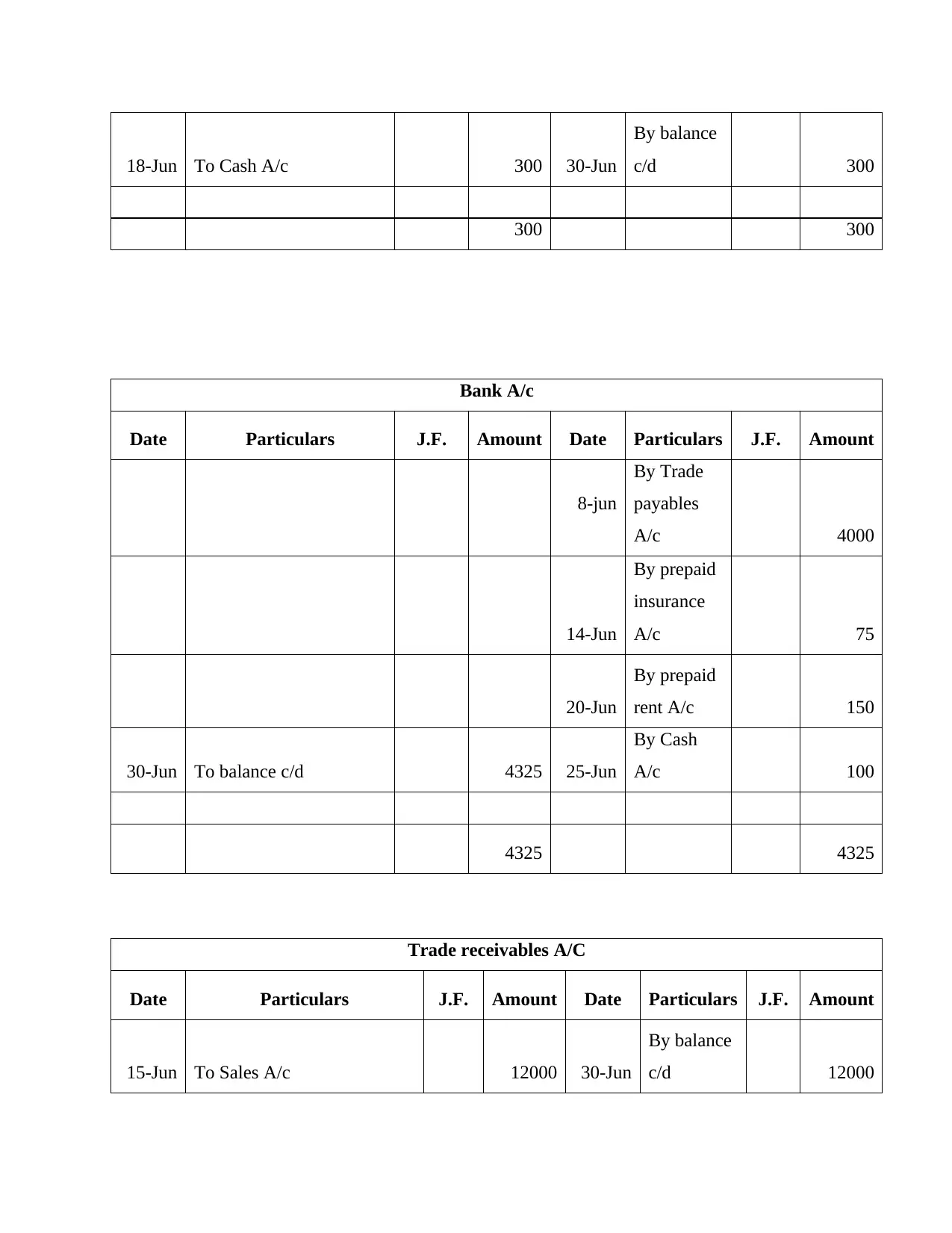
18-Jun To Cash A/c 300 30-Jun
By balance
c/d 300
300 300
Bank A/c
Date Particulars J.F. Amount Date Particulars J.F. Amount
8-jun
By Trade
payables
A/c 4000
14-Jun
By prepaid
insurance
A/c 75
20-Jun
By prepaid
rent A/c 150
30-Jun To balance c/d 4325 25-Jun
By Cash
A/c 100
4325 4325
Trade receivables A/C
Date Particulars J.F. Amount Date Particulars J.F. Amount
15-Jun To Sales A/c 12000 30-Jun
By balance
c/d 12000
By balance
c/d 300
300 300
Bank A/c
Date Particulars J.F. Amount Date Particulars J.F. Amount
8-jun
By Trade
payables
A/c 4000
14-Jun
By prepaid
insurance
A/c 75
20-Jun
By prepaid
rent A/c 150
30-Jun To balance c/d 4325 25-Jun
By Cash
A/c 100
4325 4325
Trade receivables A/C
Date Particulars J.F. Amount Date Particulars J.F. Amount
15-Jun To Sales A/c 12000 30-Jun
By balance
c/d 12000
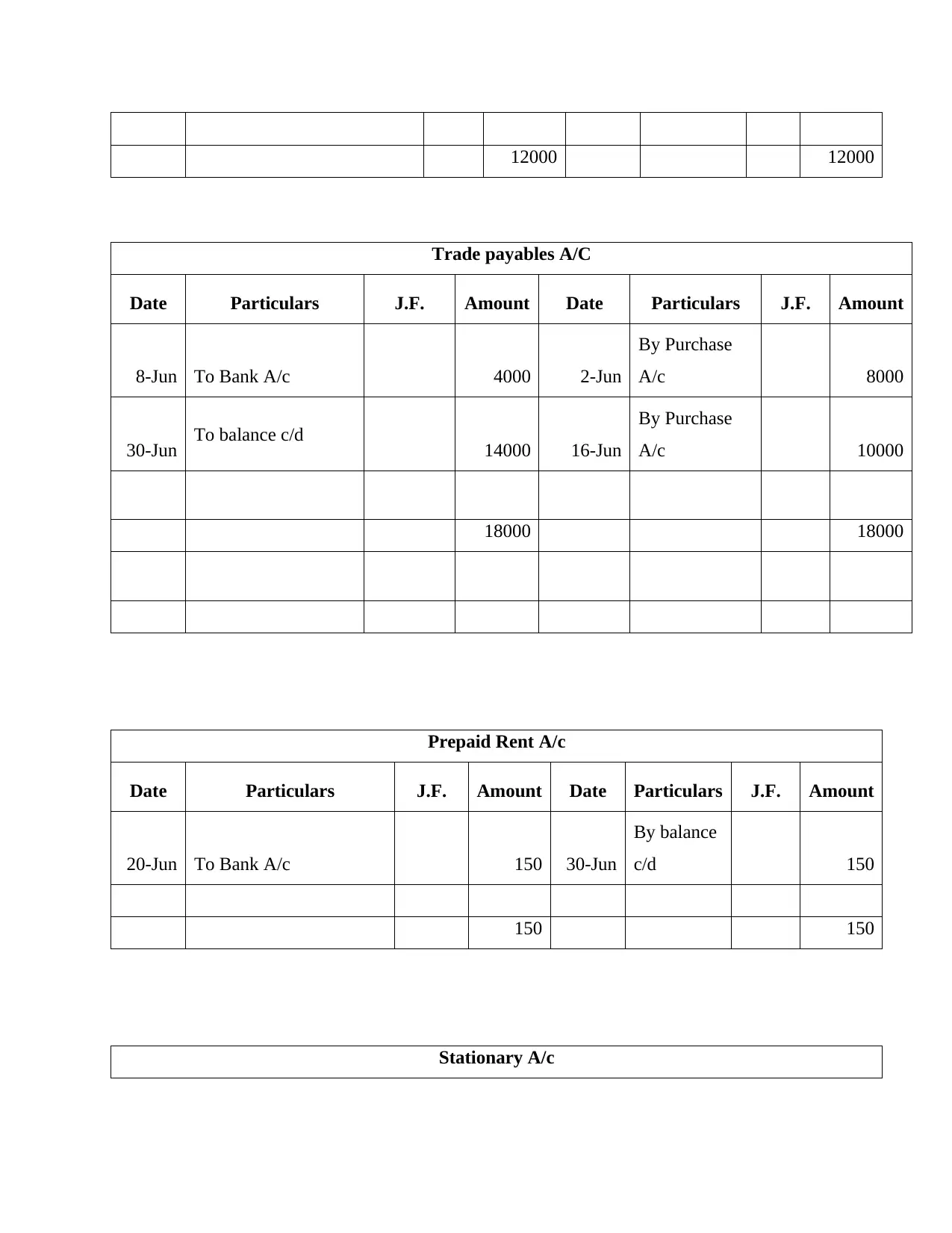
12000 12000
Trade payables A/C
Date Particulars J.F. Amount Date Particulars J.F. Amount
8-Jun To Bank A/c 4000 2-Jun
By Purchase
A/c 8000
30-Jun To balance c/d 14000 16-Jun
By Purchase
A/c 10000
18000 18000
Prepaid Rent A/c
Date Particulars J.F. Amount Date Particulars J.F. Amount
20-Jun To Bank A/c 150 30-Jun
By balance
c/d 150
150 150
Stationary A/c
Trade payables A/C
Date Particulars J.F. Amount Date Particulars J.F. Amount
8-Jun To Bank A/c 4000 2-Jun
By Purchase
A/c 8000
30-Jun To balance c/d 14000 16-Jun
By Purchase
A/c 10000
18000 18000
Prepaid Rent A/c
Date Particulars J.F. Amount Date Particulars J.F. Amount
20-Jun To Bank A/c 150 30-Jun
By balance
c/d 150
150 150
Stationary A/c
⊘ This is a preview!⊘
Do you want full access?
Subscribe today to unlock all pages.

Trusted by 1+ million students worldwide
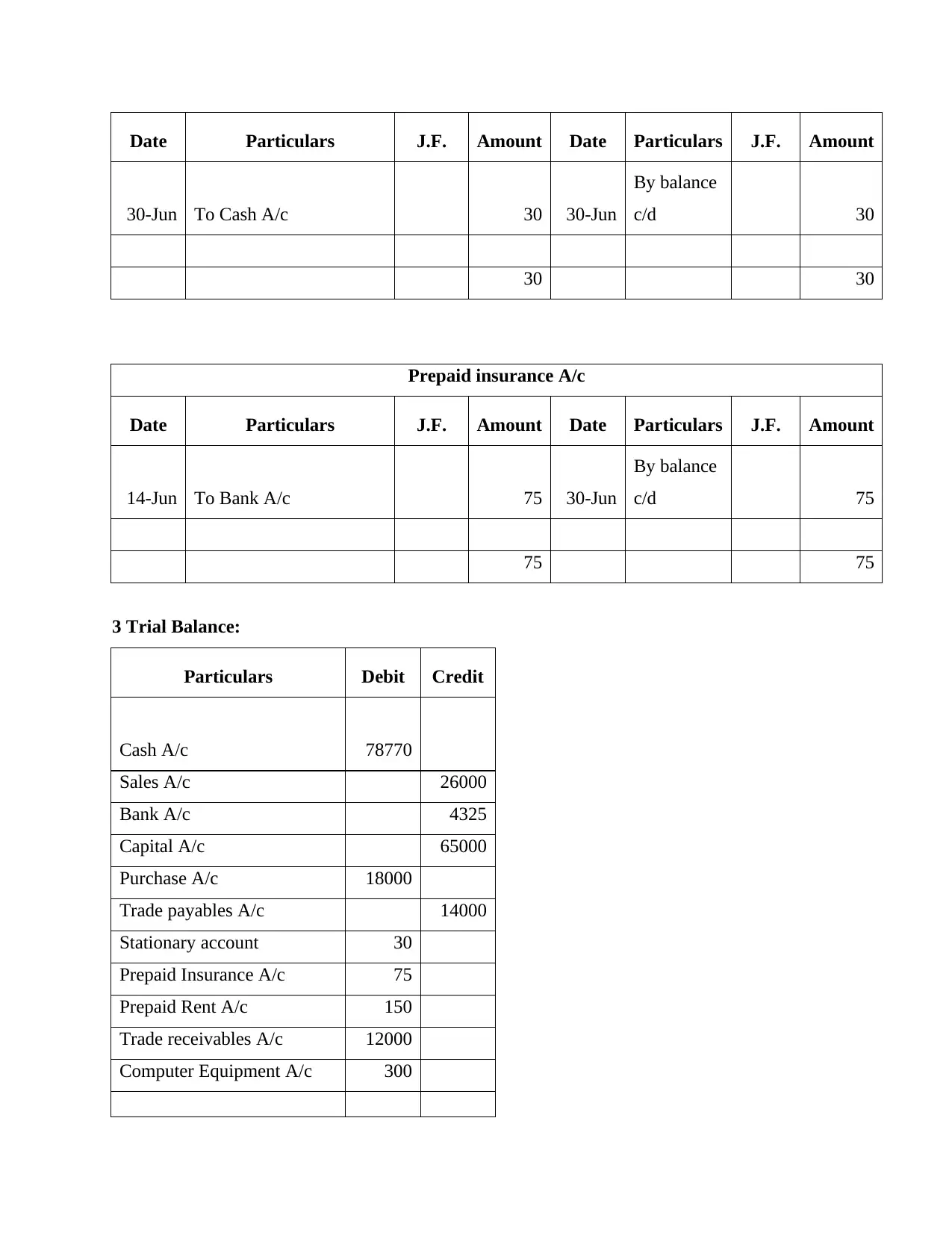
Date Particulars J.F. Amount Date Particulars J.F. Amount
30-Jun To Cash A/c 30 30-Jun
By balance
c/d 30
30 30
Prepaid insurance A/c
Date Particulars J.F. Amount Date Particulars J.F. Amount
14-Jun To Bank A/c 75 30-Jun
By balance
c/d 75
75 75
3 Trial Balance:
Particulars Debit Credit
Cash A/c 78770
Sales A/c 26000
Bank A/c 4325
Capital A/c 65000
Purchase A/c 18000
Trade payables A/c 14000
Stationary account 30
Prepaid Insurance A/c 75
Prepaid Rent A/c 150
Trade receivables A/c 12000
Computer Equipment A/c 300
30-Jun To Cash A/c 30 30-Jun
By balance
c/d 30
30 30
Prepaid insurance A/c
Date Particulars J.F. Amount Date Particulars J.F. Amount
14-Jun To Bank A/c 75 30-Jun
By balance
c/d 75
75 75
3 Trial Balance:
Particulars Debit Credit
Cash A/c 78770
Sales A/c 26000
Bank A/c 4325
Capital A/c 65000
Purchase A/c 18000
Trade payables A/c 14000
Stationary account 30
Prepaid Insurance A/c 75
Prepaid Rent A/c 150
Trade receivables A/c 12000
Computer Equipment A/c 300
Paraphrase This Document
Need a fresh take? Get an instant paraphrase of this document with our AI Paraphraser
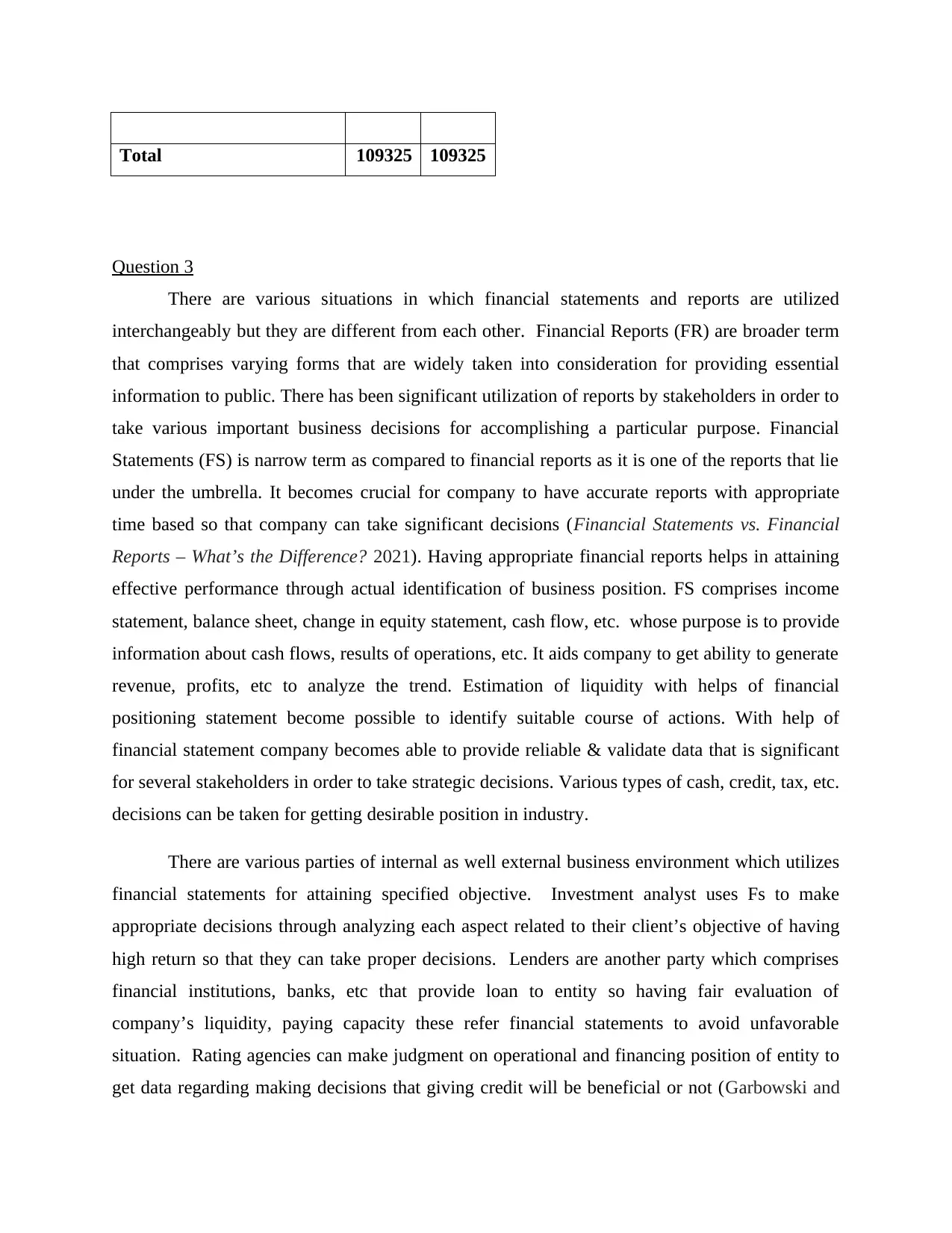
Total 109325 109325
Question 3
There are various situations in which financial statements and reports are utilized
interchangeably but they are different from each other. Financial Reports (FR) are broader term
that comprises varying forms that are widely taken into consideration for providing essential
information to public. There has been significant utilization of reports by stakeholders in order to
take various important business decisions for accomplishing a particular purpose. Financial
Statements (FS) is narrow term as compared to financial reports as it is one of the reports that lie
under the umbrella. It becomes crucial for company to have accurate reports with appropriate
time based so that company can take significant decisions (Financial Statements vs. Financial
Reports – What’s the Difference? 2021). Having appropriate financial reports helps in attaining
effective performance through actual identification of business position. FS comprises income
statement, balance sheet, change in equity statement, cash flow, etc. whose purpose is to provide
information about cash flows, results of operations, etc. It aids company to get ability to generate
revenue, profits, etc to analyze the trend. Estimation of liquidity with helps of financial
positioning statement become possible to identify suitable course of actions. With help of
financial statement company becomes able to provide reliable & validate data that is significant
for several stakeholders in order to take strategic decisions. Various types of cash, credit, tax, etc.
decisions can be taken for getting desirable position in industry.
There are various parties of internal as well external business environment which utilizes
financial statements for attaining specified objective. Investment analyst uses Fs to make
appropriate decisions through analyzing each aspect related to their client’s objective of having
high return so that they can take proper decisions. Lenders are another party which comprises
financial institutions, banks, etc that provide loan to entity so having fair evaluation of
company’s liquidity, paying capacity these refer financial statements to avoid unfavorable
situation. Rating agencies can make judgment on operational and financing position of entity to
get data regarding making decisions that giving credit will be beneficial or not (Garbowski and
Question 3
There are various situations in which financial statements and reports are utilized
interchangeably but they are different from each other. Financial Reports (FR) are broader term
that comprises varying forms that are widely taken into consideration for providing essential
information to public. There has been significant utilization of reports by stakeholders in order to
take various important business decisions for accomplishing a particular purpose. Financial
Statements (FS) is narrow term as compared to financial reports as it is one of the reports that lie
under the umbrella. It becomes crucial for company to have accurate reports with appropriate
time based so that company can take significant decisions (Financial Statements vs. Financial
Reports – What’s the Difference? 2021). Having appropriate financial reports helps in attaining
effective performance through actual identification of business position. FS comprises income
statement, balance sheet, change in equity statement, cash flow, etc. whose purpose is to provide
information about cash flows, results of operations, etc. It aids company to get ability to generate
revenue, profits, etc to analyze the trend. Estimation of liquidity with helps of financial
positioning statement become possible to identify suitable course of actions. With help of
financial statement company becomes able to provide reliable & validate data that is significant
for several stakeholders in order to take strategic decisions. Various types of cash, credit, tax, etc.
decisions can be taken for getting desirable position in industry.
There are various parties of internal as well external business environment which utilizes
financial statements for attaining specified objective. Investment analyst uses Fs to make
appropriate decisions through analyzing each aspect related to their client’s objective of having
high return so that they can take proper decisions. Lenders are another party which comprises
financial institutions, banks, etc that provide loan to entity so having fair evaluation of
company’s liquidity, paying capacity these refer financial statements to avoid unfavorable
situation. Rating agencies can make judgment on operational and financing position of entity to
get data regarding making decisions that giving credit will be beneficial or not (Garbowski and
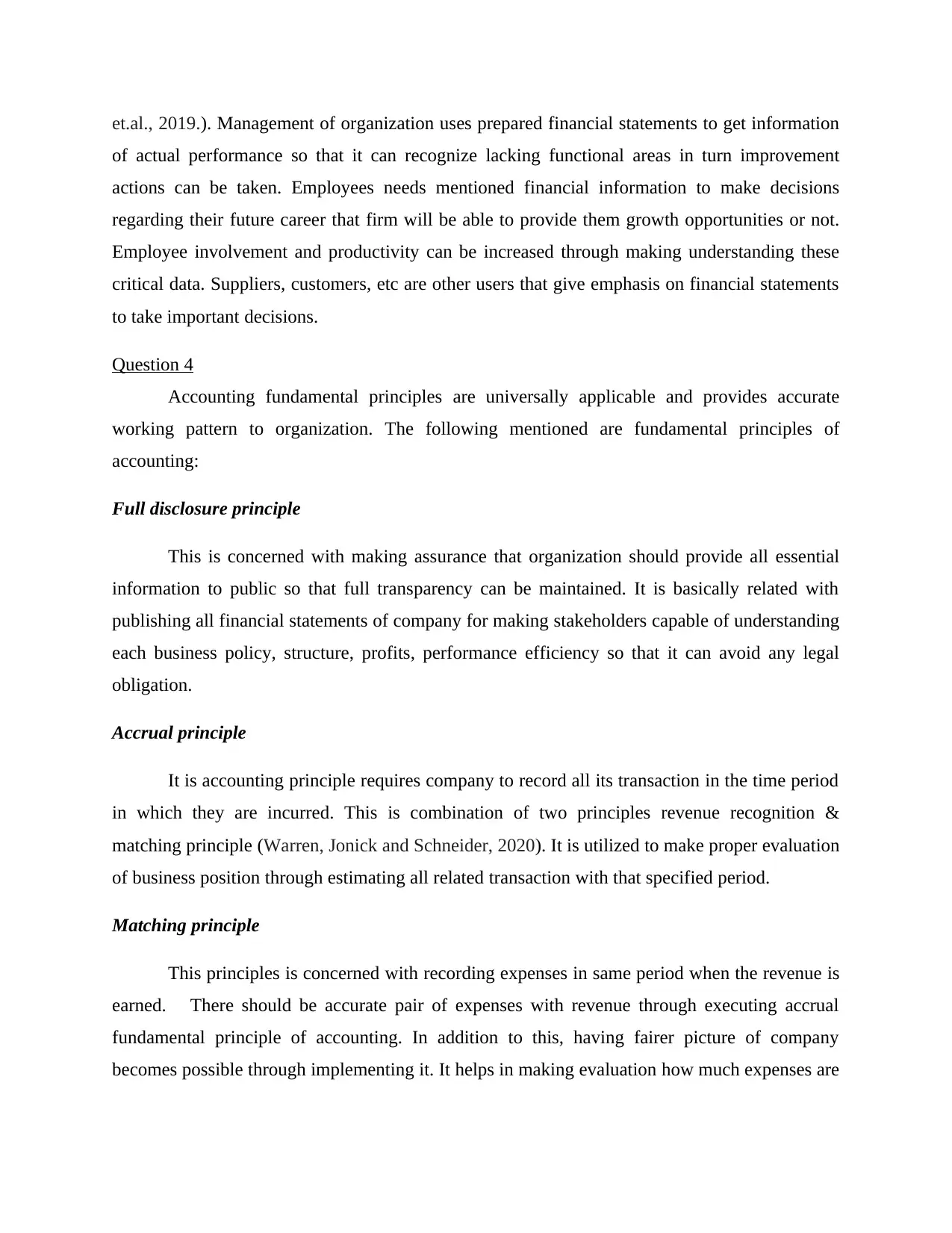
et.al., 2019.). Management of organization uses prepared financial statements to get information
of actual performance so that it can recognize lacking functional areas in turn improvement
actions can be taken. Employees needs mentioned financial information to make decisions
regarding their future career that firm will be able to provide them growth opportunities or not.
Employee involvement and productivity can be increased through making understanding these
critical data. Suppliers, customers, etc are other users that give emphasis on financial statements
to take important decisions.
Question 4
Accounting fundamental principles are universally applicable and provides accurate
working pattern to organization. The following mentioned are fundamental principles of
accounting:
Full disclosure principle
This is concerned with making assurance that organization should provide all essential
information to public so that full transparency can be maintained. It is basically related with
publishing all financial statements of company for making stakeholders capable of understanding
each business policy, structure, profits, performance efficiency so that it can avoid any legal
obligation.
Accrual principle
It is accounting principle requires company to record all its transaction in the time period
in which they are incurred. This is combination of two principles revenue recognition &
matching principle (Warren, Jonick and Schneider, 2020). It is utilized to make proper evaluation
of business position through estimating all related transaction with that specified period.
Matching principle
This principles is concerned with recording expenses in same period when the revenue is
earned. There should be accurate pair of expenses with revenue through executing accrual
fundamental principle of accounting. In addition to this, having fairer picture of company
becomes possible through implementing it. It helps in making evaluation how much expenses are
of actual performance so that it can recognize lacking functional areas in turn improvement
actions can be taken. Employees needs mentioned financial information to make decisions
regarding their future career that firm will be able to provide them growth opportunities or not.
Employee involvement and productivity can be increased through making understanding these
critical data. Suppliers, customers, etc are other users that give emphasis on financial statements
to take important decisions.
Question 4
Accounting fundamental principles are universally applicable and provides accurate
working pattern to organization. The following mentioned are fundamental principles of
accounting:
Full disclosure principle
This is concerned with making assurance that organization should provide all essential
information to public so that full transparency can be maintained. It is basically related with
publishing all financial statements of company for making stakeholders capable of understanding
each business policy, structure, profits, performance efficiency so that it can avoid any legal
obligation.
Accrual principle
It is accounting principle requires company to record all its transaction in the time period
in which they are incurred. This is combination of two principles revenue recognition &
matching principle (Warren, Jonick and Schneider, 2020). It is utilized to make proper evaluation
of business position through estimating all related transaction with that specified period.
Matching principle
This principles is concerned with recording expenses in same period when the revenue is
earned. There should be accurate pair of expenses with revenue through executing accrual
fundamental principle of accounting. In addition to this, having fairer picture of company
becomes possible through implementing it. It helps in making evaluation how much expenses are
⊘ This is a preview!⊘
Do you want full access?
Subscribe today to unlock all pages.

Trusted by 1+ million students worldwide
1 out of 26
Related Documents
Your All-in-One AI-Powered Toolkit for Academic Success.
+13062052269
info@desklib.com
Available 24*7 on WhatsApp / Email
![[object Object]](/_next/static/media/star-bottom.7253800d.svg)
Unlock your academic potential
Copyright © 2020–2025 A2Z Services. All Rights Reserved. Developed and managed by ZUCOL.




